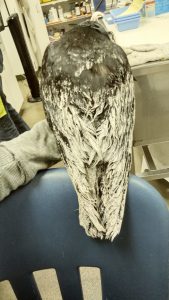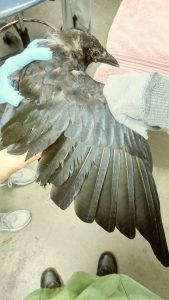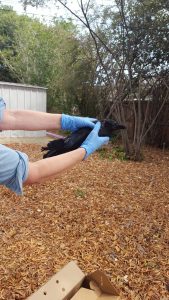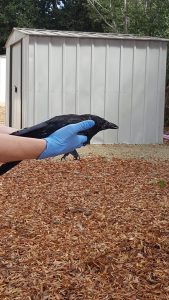What happened after one crow’s terrible, horrible, no good, very bad day
by Leslie Weir
Have you ever wondered what happens when a wild bird needs help? Are you curious about what it takes to save the life of a single bird in crisis? I can tell you from recent experience that it takes the commitment of a lot of people with a lot of compassion. It takes a lot of time, a lot of patience, a lot of resources, and often, a little bit of sleuthing. This is the story of an American Crow that one morning in March, made a near-fatal mistake, but thanks to multiple people in multiple places, it has a happy ending.
Shortly before joining the staff at Golden Gate Bird Alliance, I worked at the Fred Finch Youth Center in Oakland. Driving into work one morning I noticed an unusual bird in the parking lot. It was the size and shape of a crow, but it had a black head and a white body. It quickly became clear that an American Crow had misjudged and landed in a vat of paint (or something.) Hoping to make a rescue, I retrieved a box and a willing co-worker from my office, but by the time we returned to the parking lot the bird had disappeared.
The employees at Fred Finch weren’t willing to give up. They kept a constant look out, made several sighting and a few attempts at capture, but the crow had enough flight to evade their attempts. Finally, over a week after the first sighting, the crow had lost the ability to escape by flight and four employees banded together, corralling the weakened bird and delivering it to the Lindsay Wildlife Experience hospital.

The crow’s intake exam recorded that the back, wing, tail feathers and an area around the eyes were matted with paint. And, even more worrisome, the bird had a scab and large area of infection on the left side. Initial care required the administration of subcutaneous fluids for dehydration, as well as antibiotics and anti-inflammatory medication. The wound was flushed and bandaged. Further testing on Day 2 showed evidence of parasites, requiring additional medication, and the wound continued to show signs of severe infection.
By Day 3 it became clear that the crow would need to be placed under anesthesia so that the wound could be debrided (a painstakingly slow process of removing infected and dead tissue) and sutured.
On Day 6 the Lindsay staff felt the wound was healing well enough and that the crow had regained enough strength to withstand an attempt to wash the paint off the feathers. But what product would work to get the bird clean? Remember I said there was a little bit of sleuthing involved? To avoid traumatizing the crow through multiple trial washings, the veterinary technician removed a contaminated feather and began testing. Everything proved ineffective on the test feather and International Bird Rescue (IBR), another rescue organization with decades of experience in washing contaminated birds, was consulted for advice.
Meanwhile, back at Fred Finch Youth Center, one of the rescuers was determined to identify the contaminant and searched the neighborhood for possible clues. The discovery that a nearby house was coating the roof with waterproof sealant provided the answer.
On Day 14 of hospitalization, the crow was again put under anesthesia, this time for washing. Two products were tried to determine the best approach. Primary feathers on the right side of the bird were cleaned with coconut oil and baking soda (IBR’s suggestion); primaries on the left with De-Solv-it (the sealant manufacturer’s suggestion.) The removal technique required saturating and deeply massaging the feathers with cleaner, then carefully scraping away the contaminant, followed by a wash with Dawn detergent and extensive rinsing. Even this slow and elaborate process was only marginally successful and two additional washes were performed during the bird’s third week in care.

With most of the sealant removed, the veterinary technicians at Lindsay were able to fully assess the crow’s feather health. All primary tips were damaged or broken; all secondaries on both wings frayed or broken. It was clear from the damaged feathers and additional waterproofing concerns, that the patient needed to be kept in care to molt. The crow had already been at the hospital for a month and would need several more months under the watch of the Lindsay team.
Throughout the bird’s first month in care it was receiving two volunteer-prepared meals a day. The meals were designed to provide maximum nutrition and tracked daily for adjustments based on weight gain or loss and amounts eaten. Volunteers also provided daily cage cleaning and enrichment, like pinecones, to stave off bird boredom. The bird’s next stop on it’s recovery journey would require long term space in an aviary and it would need to leave Lindsay’s holding room and army of volunteers to make room for new patients. A volunteer from Lindsay’s homecare team offered her backyard aviary. This single volunteer took on the responsibility of daily feedings and cleanings, and periodic trips to Lindsay’s hospital for check ups.

Finally, nearly 6 months after the unfortunate day when the crow touched down in a vat of sealant, it was ready for release. The bird was given a feather check and flight test and, although still showing bits of sealant here and there, the patient was ready for release. The final moment of care provided by the veterinary technician at Lindsay was a “pedicure” to re-sharpen talons dulled by months in captivity. I retrieved the crow and transported it to the exact spot from which it had been rescued, inviting rescuers to witness its returned. After taking a moment to adjust, it quickly took flight into the nearest tree.


And there you have it; dozens of wildlife professionals, volunteers, and committed rescuers; hundreds of meals; thousands of hours of care and recovery; all culminating in a split second flight back to the wild. That is what it takes to save the life of a single bird in crisis.
Click here to watch the release.
Leslie Weir is the new Development and Communications Manager at GGBA. She is an active animal rehabilitation volunteer at both Lindsay Wildlife Experience Hospital and International Bird Rescue.
